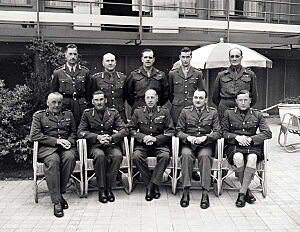Bruce Matthews (Canadian Army officer) facts for kids
Quick facts for kids
Albert Bruce Matthews
CBE DSO ED
|
|
|---|---|
 |
|
| Born | 12 August 1909 Ottawa, Ontario |
| Died | 12 September 1991 (aged 82) |
| Service/ |
Canadian Army |
| Years of service | 1928–1945 |
| Rank | Major General |
| Unit | Royal Canadian Artillery |
| Commands held | 5th Medium Regiment, Royal Canadian Artillery 2nd Canadian Infantry Division |
| Battles/wars | World War II |
| Awards | Distinguished Service Order Commander of the Order of the British Empire Honorary citizenship of the city of Groningen |
| Relations | Albert Edward Matthews (father) |
| Other work | Colonel commandant of the Royal Regiment of Canadian Artillery President Liberal Party of Canada |
Major General Albert Bruce Matthews (born August 12, 1909 – died September 12, 1991) was an important Canadian Army officer and a successful businessman. Even though he wasn't a career soldier, he became a top commander of the 2nd Canadian Infantry Division during the end of World War II. He fought bravely in Sicily, Italy, and Western Europe from 1943 to 1945.
People knew him for his courage and for how well his artillery units fired. After the war, he went back to business. He was also active in Canadian politics with the Liberal Party of Canada.
Contents
Early Life and Family
Bruce Matthews was born in 1909. His father, Albert Edward Matthews, was a well-known businessman. He later became the Lieutenant-Governor of Ontario in 1937.
Bruce Matthews went to Upper Canada College in Toronto. He also studied at the University of Geneva. After his studies, he joined his family's business. In 1937, Matthews married Victoria Thorne. They had one child before the war started. Later, they had twins in 1941, but Matthews didn't meet them until 1945.
Military Career in World War II
Matthews first tried to join the military in 1927 but was turned down. He was also rejected by the navy because he was color blind. However, in 1928, he joined a part-time army group called the Non-Permanent Active Militia. He became a provisional lieutenant in the Royal Canadian Artillery.
He was promoted to captain in 1933 and major in 1938. When World War II began in September 1939, Matthews was sent to the United Kingdom. He was part of the 1st Canadian Division.
Matthews quickly rose through the ranks during the war. In 1941, he became a lieutenant-colonel and started the 5th Medium Regiment, Royal Canadian Artillery. In January 1943, at age 33, he became a brigadier. This made him the youngest brigadier in the Canadian Army at that time. He was in charge of the artillery for the 1st Canadian Division.
Fighting in Sicily and Italy
Matthews' active service began in July 1943 in Sicily. He helped direct naval gunfire and found places for his artillery guns. He did this even while under enemy fire. This was during the attack on Agira. In September 1943, he moved to the Italian mainland. He was later given the Distinguished Service Order for his bravery. He went forward under German fire to find good spots for his guns.
Normandy and Western Europe
In January 1944, Matthews returned to the United Kingdom. He was then put in charge of the artillery for the II Canadian Corps. This was a very important job for an artillery officer. The II Corps joined the fighting in Normandy on July 11, 1944. They took part in several battles during the Battle of Normandy. Matthews planned how the artillery would fire in these big operations.
Matthews was very skilled at coordinating large artillery attacks. This was clear in Normandy and during the fighting in Walcheren. In November 1944, he was promoted to major general. He became the commander of the 2nd Canadian Infantry Division. He helped this division become very effective again after tough battles on the Scheldt.
His division fought in the Rhineland battles in February and March 1945. They advanced through Kalkar, the Hochwald, and Xanten to Wesel. They almost stopped the Germans from blowing up the Rhine bridges. After crossing the Rhine, Matthews' division freed the northern Netherlands. They then moved quickly to guard another army group. The Canadians captured Oldenburg. They were close to Wilhelmshaven when the war ended on May 5, 1945.
After the War
After the war, Matthews chose not to continue his military career. He returned to business in Canada. He became a director for several companies, including Excelsior Life and Dome Mines. He was also the chairman of Massey Ferguson for a short time in 1978. He was also president of the Argus Corporation.
In politics, he served as President of the Liberal Party of Canada from the late 1950s to the early 1960s. From 1964 to 1969, he was the Colonel commandant of the Royal Regiment of Canadian Artillery.
Albert Bruce Matthews passed away in September 1991, shortly after his 82nd birthday.


